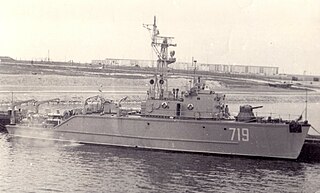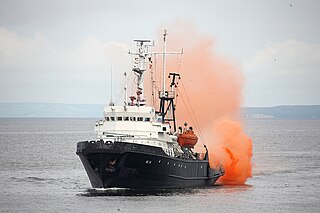
The Finnish Navy is one of the branches of the Finnish Defence Forces. The navy employs 2,300 people and about 4,300 conscripts are trained each year. Finnish Navy vessels are given the ship prefix "FNS", short for "Finnish Navy ship", but this is not used in Finnish-language contexts. The Finnish Navy also includes coastal forces and coastal artillery.

The Soviet Navy was the naval warfare uniform service branch of the Soviet Armed Forces. Often referred to as the Red Fleet, the Soviet Navy made up a large part of the Soviet Union's strategic planning in the event of a conflict with the opposing superpower, the United States, during the Cold War (1945–1991). The Soviet Navy played a large role during the Cold War, either confronting the North Atlantic Treaty Organization in western Europe or power projection to maintain its sphere of influence in eastern Europe.

The Tarantul-class corvette, Soviet designation Project 1241 Molniya are a class of Russian missile corvettes.

The Black Sea Fleet is the fleet of the Russian Navy in the Black Sea, the Sea of Azov and the Mediterranean Sea. The Black Sea Fleet, along with other Russian ground and air forces on the Crimean Peninsula, are subordinate to the Southern Military District of the Russian Armed Forces. The fleet traces its history to its founding by Prince Potemkin on 13 May 1783 as part of the Imperial Russian Navy. The Russian SFSR inherited the fleet in 1918; with the founding of the Soviet Union in 1922, it became part of the Soviet Navy. Following the collapse of the Soviet Union in 1991, the Black Sea Fleet was partitioned between the Russian Federation and Ukraine in 1997, with Russia receiving title to 82% of the vessels.

The Ukrainian Navy is the maritime forces of Ukraine and one of the five branches of the Armed Forces of Ukraine.

The Baltic Fleet is the fleet of the Russian Navy in the Baltic Sea.

The Krivak class, Soviet designation Project 1135 Burevestnik, are a series of frigates and patrol ships built in the Soviet Union primarily for the Soviet Navy since 1970. Later some sub-branches, like the Nerey (Nereus) were designed for coastal patrol by the KGB Border Troops. Until 1977, the ships in the class were considered to be large anti-submarine warfare vessels.

Chernihiv (U310) was a Natya-class minesweeper of the Ukrainian Navy captured by the Russian Navy when the Black Sea Fleet seized Ukraine's Southern Naval Base, during the 2014 Crimean crisis.
The Yurka class were a group of minesweepers built for the Soviet Navy and export customers between 1963 and 1970. The Soviet designation was Project 266 Rubin.

The Vanya class were a series of minesweepers built for the Soviet Navy between 1960 and 1973. The Soviet designation was Project 257.

The Sonya class, Soviet designation Project 1265 Yakhont, are a group of minesweepers built for the Soviet Navy and Soviet allies between 1971 and 1991.
The Sasha class is the NATO reporting name for a class of minesweepers built for the Soviet Navy between 1954 and 1956. The Soviet designation was Project 265.

The Matka class is the NATO reporting name for a group of hydrofoil missile boats built for the Soviet Navy. The Soviet designation was Project 206MR Vikhr. Following the 1997 Black Sea Fleet partition treaty all Black Sea Fleet Matka class boats were passed to the Ukrainian Navy.
INS Pondicherry (M61) was a Pondicherry class minesweeper in service with the Indian Navy, built by the Sredne-Nevskiy Shipyard at Saint Petersburg in Russia. She was the lead ship of this class. Pondicherry served the Indian Navy from 1978 to 2007. She was named after Puducherry, a union territory of India which at the time was known as Pondicherry.

The Pacific Fleet is the Russian Navy fleet in the Pacific Ocean. Established in 1731 as part of the Imperial Russian Navy, the fleet was known as the Okhotsk Military Flotilla (1731–1856) and Siberian Military Flotilla (1856–1918), formed to defend Russian interests in the Russian Far East region along the Pacific coast. In 1918 the fleet was inherited by the Russian Soviet Federative Socialist Republic, then the Soviet Union in 1922 as part of the Soviet Navy, being reformed several times before being disbanded in 1926. In 1932 it was re-established as the Pacific Fleet, and was known as the Red Banner Pacific Fleet after World War II as it had earned the Order of the Red Banner. In the Soviet years, the fleet was also responsible for the Soviet Navy's operations in the Indian Ocean and Arabian Sea. Following the collapse of the Soviet Union in 1991, the Red Banner Pacific Fleet was inherited by the Russian Federation as part of the Russian Navy and its current name was adopted.

The Fugas class were a group of minesweepers built for the Soviet Navy in the 1930s and 1940s. The Soviet designations were Project 3, Project 53, Project 53-U and Project 58.

The Sorum class, Soviet designation Project 745, is a series of seagoing tugs built for the Soviet Navy and KGB Border Troops, and later operated by the Russian Navy and FSB Border Service.














